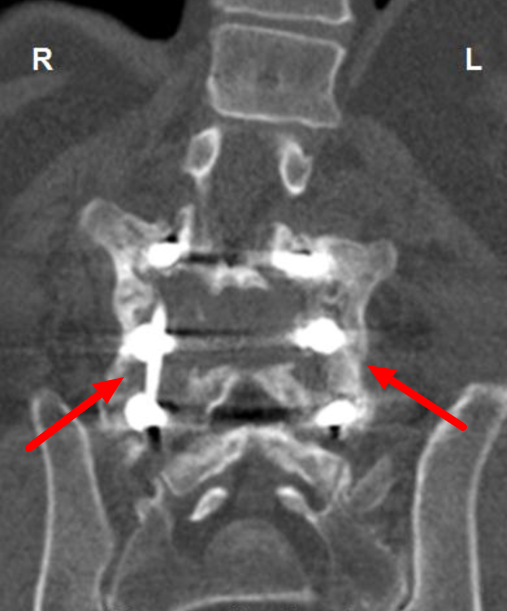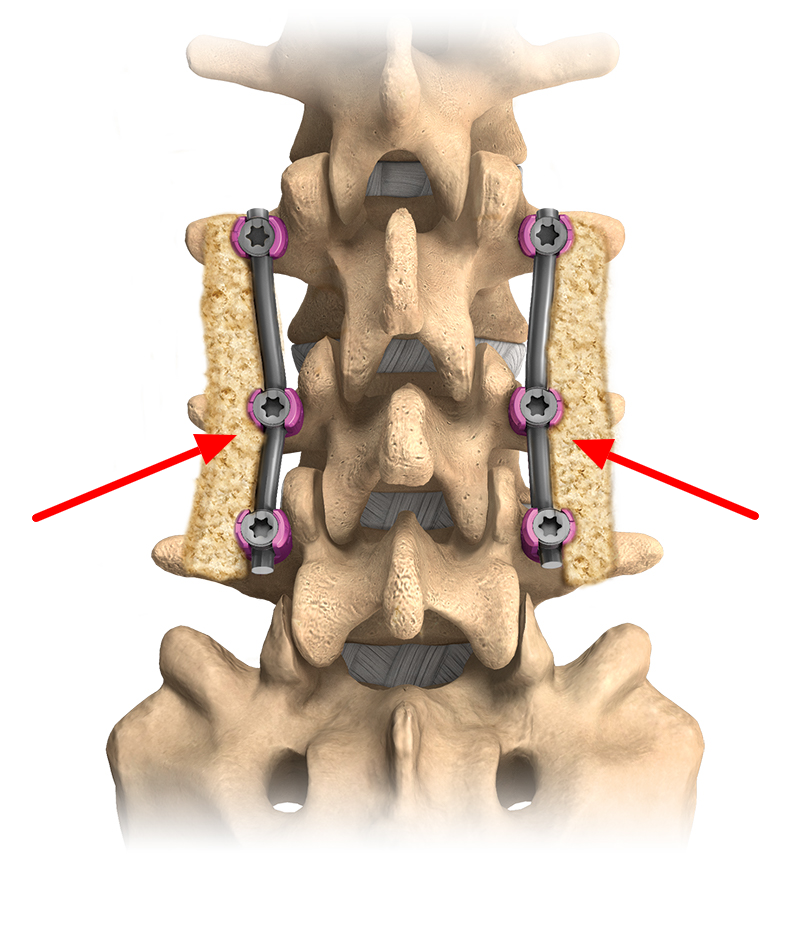
Follow-up CT image of a patient who underwent instrumented lumbar fusion. Note the mature bony fusion masses lateral to the screws (red arrows).

Illustration of an instrumented L3-L5 spinal fusion. Note the 3 screws on each side of the spine that are connected by vertical rods. Just lateral to the rods on each side are strips of graft material (red arrows) spanning across the transverse processes (bony projections off each bone) that will eventually lead to a vertical bony fusion mass connecting the L3-5 vertebrae.
What is spinal fusion?
Spinal fusion is combining two or more vertebrae by inserting secondary bone tissue to increase the bone healing process and fuse them together. This secondary tissue can be obtained either through autograft (tissues from the same person) or allograft (tissues from another person).
Spinal fusion is more commonly done to the lumbar region (lower back) of the spine rather than the cervical (neck) or thoracic (mid back) regions, but it can be performed at any level if needed. Thoracic is more immobile (due to the rib cage) and thus tends to require fusion less frequently. In contrast, the lumbar region is more prone to degeneration due to increased motion and stress. This section will focus mainly on lumbar spinal fusion. Talk to your doctor or contact us if you have any questions on spinal fusion in the cervical or thoracic regions.
When is lumbar spinal fusion recommended?
Usually spinal fusion is recommended in patients with neurological problems or severe pain that hasn’t responded to non-surgical or conservative treatments. Lumbar fusion may be indicated if the spine has instability or if instability will be created through another medically necessary spine procedure such as removal of joints to enable removal of pressure on nerves or spinal cord. Spinal fusion may also be needed to help correct spinal deformities such as scoliosis.
Lumbar spinal fusion may be used to treat conditions such as:
- Spinal stenosis (narrowing of the spine)
- Damaged disc
- Spinal tumor
- Fractures of the spine
- Scoliosis and kyphosis (abnormal curvatures of the spine)
If you’re diagnosed with any of the conditions above, talk to your physician or contact us to set up an appointment to see if lumbar spinal fusion is right for you.
How is spinal fusion performed?
This procedure can be performed through different angles depending upon the specific advantages of each and the choice of your surgeon. Interbody fusion can be employed where bone graft is placed in the space present between the two vertebrae. Other techniques for spinal fusion may involve the entire removal of the disc between the affected vertebrae. A specially designed device made of plastic or titanium may be placed between the vertebrae to help maintain spine alignment and normal height of the disc.
Whichever technique is used, fixation will be done after that involves fitting of metallic screws, rods, plates or cages to stabilize the vertebrae and accelerate bone fusion. Complete fusion can take several months or even a year or two. Patients are often healed on the outside long before the healing process on the inside is finished.
What are the risks and complications of spinal fusion?
As with all surgical procedures, spinal fusion carries risks and complications such as:
- Infection
- Nerve/spinal cord damage
- Blood clots
- Blood loss
- Bowel and bladder problems
- Adverse effects of anesthesia
- Failure to fuse
- Failure of instrumentation
- Need for future surgery
- Durotomy (opening of the spinal fluid sac)
The primary risk of spinal fusion is failure of the vertebral bones to fuse together, which may require additional surgery.
Before going ahead with any surgical procedure, educate yourself and make an informed decision! Talk to your surgeon, or contact us to setup an appointment if you have any questions, comments, or concerns about spinal fusion.

